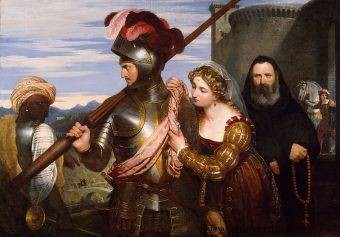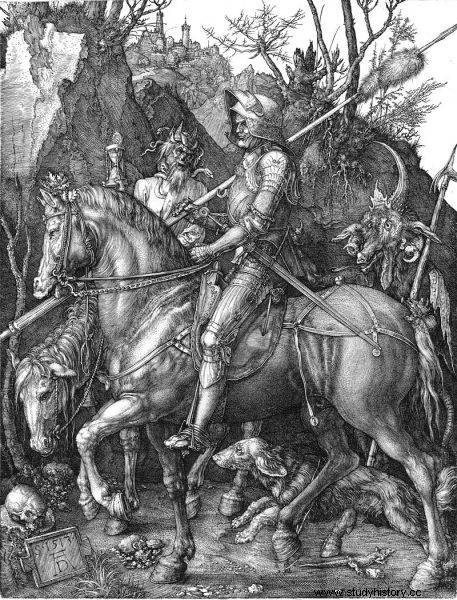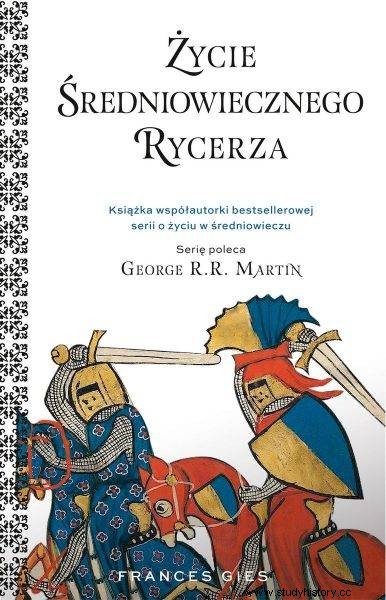The medieval knight was fond of the warrior. Counting on loot to win, he went into battle as if he were fighting in a tournament. He had no mercy for his enemies and was ready for anything for money. On the other hand, his great deeds were sung in songs, and legends spoke of courage and loyalty. It was knights who decided about the course of medieval history. What were they really like? Which of their "version" is the real one?
On November 27, 1095, Pope Urban II announced in Clermont, central France, the first crusade, in an open field outside the city, in a setting similar to those in which the call for the Peace of God was. Chroniclers recorded that countless crowds cried and picked up on this appeal, expressing their support with stomping, and collective enthusiasm reached its peak with a loud cry:"God wants it so!" (…).

It was knights who decided about the course of medieval history. What were they really like? Which of their "version" is the real one?
During the next eight months, Pope Urban traveled around France, calling for participation in the crusade, and thousands of knights joined the banners of local nobles, such as Count Raymond IV of Toulouse, Count Hugo de Vermandois (called the Younger; brother of King Philip), Count Gotfried of Bouillon, Count Robert of Flanders, Duke of Normandy Robert, and Bohemond I de Hauteville, the Norman ruler of Taranto in southern Italy. Five knightly armies were set up, and in 1096 they set out by land and sea for Constantinople, which was to be the base for an attack on the Saracens.
Military elite
These knights came from France and neighboring lands:they were Lorraine, Norman, Flemish, Burgundian; they came from the north and south of France, from Germany and Italy. They differed from one another depending on the region they came from - in terms of social position, lifestyle, and the degree to which they were connected with the feudal hierarchy - but they all felt the changes that occurred after A.D. 1000 in the status of knights, the law of inheritance, as well as the very idea of knighthood. In fact, all these changes were to a large extent the impetus for participation in the crusade (...).
As a result of the Peace of God and the Christianization of knighthood the title of knight became prestigious and even great lords accepted it with pride and this prestige lent the cohesion of this essentially two-tier upper class. Seniors and castellans, representatives of a very small group of families who had inherited aristocratic estates and titles for a long time, exercised complete power over vast areas, ruling and punishing there, collecting taxes, presiding at court hearings and appointing subjects to military service.

As a result of the Peace of God and the Christianization of chivalry, the title of knight became prestigious and even great lords accepted it with pride
Knights, in turn, were small landowners, as vassals burdened with certain obligations, but otherwise independent of the castellan's power, masters in their relatively small estates. Simple knights could marry daughters or sisters of castellans; castellans chose candidates for wives for themselves and their sons from among people from their own circle. Nevertheless, both groups shared a strong sense of class solidarity as members of the military elite, elevated above the rest of the population by their military profession and united by the knighting ceremony and the title of chivalry.
However, at the same time as the knights climbed the social ladder, they felt the effects of catastrophic economic difficulties, which forced changes in the organization of family life and customs related to inheritance, which in turn seriously affected the institution of knighthood. (...) We do not know the mechanisms that brought about an important historical change, but at the end of the 11th century, almost everywhere, the traditional division of inherited land possessions was replaced by the taking over of the inheritance by the sole heir (...).
Hereditary caste
At the beginning of the 11th century, knighthood was still an open social class. Anyone who could afford a steed, armor and other appropriate equipment, and villagers could belong to her who would work the soil in his absence. But the knightly caste did not have to worry too much about the influx of upstarts. The great boom in trade in the Middle Ages, although it was already beginning then, made relatively few merchants and peasants by then.
(...) The material condition of the knights improved due to the general improvement of the economic situation (...). With the strengthening of family solidarity and the decline of individual property, knighthood began to be considered hereditary. After 1050, the title of knight was usually passed from father to son, and what was previously "rank" became a distinguishing feature of a hereditary caste, closed to new people and reserved for its existing members and their heirs. No peasant or merchant could penetrate her, no matter how wealthy he was.
As chivalry became hereditary, the upper class became increasingly feudalized. In England, after the Norman conquest, a symmetrical fiefdom was created with the king at the top, mighty barons below it, then lesser lords and finally knights. In central France, the feudal system was organized less tightly, and the hierarchy there turned out to be somewhat less rigid. While in Norman England feudal fiefs were the dominant form of land lease, in central France it was different. Allodias still prevailed there, and fiefdoms made up only a small part of the property of knights or castellans.

The text is an excerpt from the book by Frances Gies "Życie medieval knight", which has just been released by the Znak Horyzont publishing house.
The network of feudal tributes began to entangle the gentlemen in the castles, but as a rule these tributes only strengthened mutual friendly relations and strengthened the sense of security, rather than emphasizing domination and submission . Sometimes the castellan kept arable land for himself away from his castle, which made it difficult for him to defend it or supervise its cultivation. By handing them over as a fief to another feudal lord who lived nearby, he established friendly ties with him, and he himself got rid of the trouble of managing the land.
Moreover, vassalage brought knights and magnates closer to important church centers and tightened their mutual relations. In the Mâcon region, even before the time of the First Crusade, all the knights around the local castle were vassals of the castellan, and those who lived in the vicinity of a great sanctuary such as Cluny Abbey were vassals of the local abbot. Often some knights were also vassals of other knights (…).
One great knightly family
At the time of the First Crusade, knightly fiefs were generally fields or vineyards of several acres or a single mansus (dedicated land with sufficient acreage to maintain the farm). Often the fiefs were not farmland but a church or a mill, or rents, or part of the tithes or taxes. The latter were sometimes handed over to other knights, sometimes consecutively (...).
An 11th century knight lived in the countryside and shared many common interests and concerns with the peasants , while remaining closely related to them, although he would occasionally break out of his neighborhood to hunt, perform guard duty in the castle, attend assemblies convened by a local lord, go on a pilgrimage, accompany the senior on expeditions and, above all, to cultivate the warrior who determined his social position.
He did not work in the field. He could manage its cultivation if he did not employ a manager, and it is possible that he occasionally took part in the harvest or hay-mowing, although he was not doing manual labor at the time. He was not a laborer; the daily toil fell on servants, plowmen and shepherds. His headquarters in the center of the village was not a castle, but a larger, more solidly built and better equipped version of the villagers' huts, surrounded by farm buildings, a granary and a building where the wine was stored. His prosperity depended not on his master, but on the weather and whether the harvest had been successful.

During the periodic service in the castle guard and in times of the threat of war, knights once again lived together in castles.
The knights from the vicinity of the castle were a kind of large family, interconnected by a sense of class and professional solidarity, and with the castellan - by the rules of feudal subordination. Many of them when they were boys lived together in the castle, practicing knights at that time . During the periodic service in the castle guard and in times of the threat of war, knights once again lived together in castles.
From time to time they gathered to participate in the council of the feudal lord or in trials. Moreover, almost all of them were related to each other, closer or further away. In view of the restrictions and prohibitions imposed after 1000 years on marriage by close relatives, they usually married representatives of their class from the area, as long as they did not belong to the immediate family. They also felt bound by common ancestors as descendants of the former nobility.
How to become a knight?
A juvenile knight candidate usually trained in the company of other boys at his father's master's household. In France, the certificates of the knighthood ceremony date back to the last quarter of the 11th century. In Germany, the term appeared only a century later, and such a celebration was limited to the sons of the royal family. In France, on the other hand, it included representatives of wider social groups - from male descendants of kings and counts, sons of castellans and ordinary knights.
Essentially, this involved arming a new knight and ceremoniously girdling his sword with a ribbon, which was done by a senior or an influential relative, though not necessarily someone of higher rank (a count could have been a knight of a later king). The sword itself was generally a gift given to the young knight by his patron . Several sources indicate that similar celebrations began to be made religious early on; they were usually held on church holidays and in the presence of a priest.

The sword was generally a gift given to a young knight by his patron.
As for the armor and weapons of the knight, progress in this area was very slow and gradual. The helmet, shield and chain mail were used as a cover, and the offensive weapons were a spear and a sword. Throwing weapons were left to foot soldiers. The knight contemptuously viewed the bow as something beneath his dignity - probably more because the bow cost little than because ranged combat was sometimes considered cowardice (though infantry also fought in hand-to-hand combat). Either way, it would be very difficult, if not impossible, for a horse armored knight to handle the bow efficiently.
Prices for steeds and armor rose steadily. Knight's Mount - destrier or dextrarius - bred to achieve the right size and strength, sometimes costing as much as fifty sou (or shillings in England), which is five times more than a good cow. And a knight usually needed a few horses for himself and his squires . The armor was even more expensive; in 1080, the senior of the Le Hongre brothers, Landry Gros, handed over a manor to Cluny Abbey in exchange for one hundred sou worth of chain mail. Armor and weapons were an important part of the family property, passed down from father to son.
Income obtained from the lands belonging to the knight was supplemented with loot. During constant local wars in Western Europe, horses and cattle, fodder and food were taken away. On great expeditions such as the First Crusade, these spoils were replenished, in the words of one chronicler, "with gold and silver and with many ornaments," "houses were filled with gold of all kinds" and "wonderful riches." (...) As early as the 11th century, knights began to receive money for their services, usually in times of crisis or in situations when exceptional needs arose (...).
"The theory of two swords"
Regardless of the form of remuneration, the medieval knight was fond of warrior. Among equals, counting on loot to win, he went into battle as if he were to fight in a tournament; anyway, the tournaments, especially those in the 11th century, were very similar, at least from the knights' perspective, to real battles.
War was both a profession and a kind of sport or entertainment. Small private wars rarely had any political significance. They were fought for the violation of rights to some appropriated plot of land or to take over someone else's land by force . Nation states did not yet exist. Patriotism has not yet been invented. In this situation, the only great common cause for which Europeans could fight was the Christian religion. The slogan of fighting in the name of God appeared during numerous 11th-century wars with Muslims, especially during the Reconquista in Spain. The powerful and radical Pope Gregory VII gave the idea of jihad an impetus that led to the Crusades (...).
Gregory required obedience from secular rulers in both world affairs and religious matters, and to enforce this he was willing to resort to the use of force. The laity who fought on behalf of the Pope were milites Christi - knights of Christ. For centuries the Church has consistently proclaimed the message of peace, in line with the recommendation of Saint Martin of Tours:“I am the soldier of Christ; I must not fight. " Grzegorz rejected this pacifist ideology in favor of" the theory of two swords " :the pope, as the successor of Saint Peter, wielded two weapons - a spiritual one, which he ruled himself, and another, secular one, which was ruled by nobles and knights at his command.

The tournaments, especially those in the 11th century, were very similar, at least from the knights' perspective, to real battles.
(...) The vision of a Christian soldier who fights with a sword for his salvation presented by Grzegorz turned out to be a psychological and ideological engine of the crusade. Grzegorz's successor and protégé, Urban II, used an instrument forged by his predecessor, and the effects of this influenced the fate of the world. As a result of the "great agitation in the heart of the lands of all the Franks", which he caused, the knights eagerly joined "the army of our Lord" to fight "enemies of God and ours" (...).
The enchanting temptation to go to Jerusalem was strengthened by social and economic reasons. The prospect of conquering the land lured younger sons of knights, excluded from inheritance according to the principle of primogeniture. (…) However, the essential role was undoubtedly played by religious stimuli.
"Let those who hitherto dealt with robberies become soldiers" - urged Urban, according to one version of his speech. Let those who used to stand against their brethren now fight as they should with the barbarians. [...] On the one hand there will be [...] enemies of God, on the other His friends ", And the reward for this was to be the forgiveness of sins in a new form:an indulgence for the participants of the Crusade.
(...) The chronicler Fulcher of Chartres described the departure of one of the crusaders from home:“Oh, what sorrow has come! How many sighs! How despairing! How much sobbing among loved ones when a husband left his wife dear to him, as well as children, father and mother, brothers and grandparents, and all that he had!
Check the reviews and rate the book on lubimyczyotyk.pl. "The Life of a Medieval Knight"
Source:
The text is an excerpt from the book by Frances Gies "The Life of a Medieval Knight", which has just been published by the Znak Horyzont publishing house.
